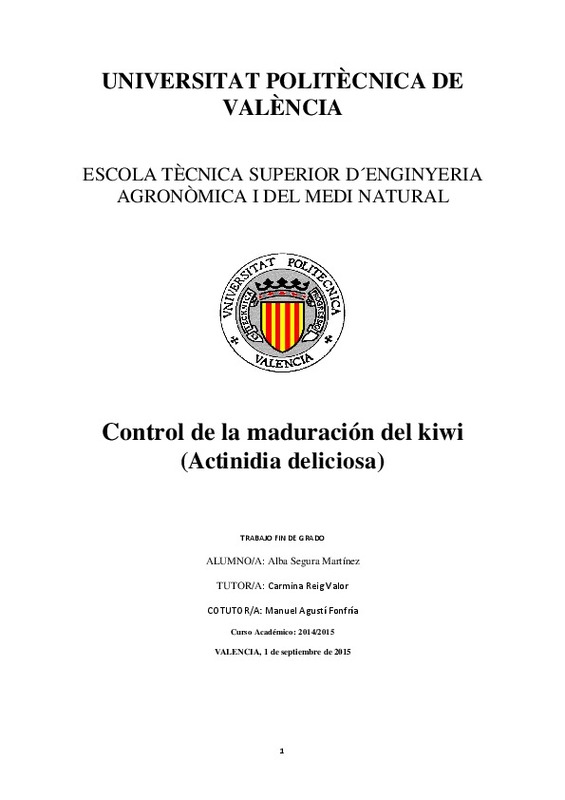|
Resumen:
|
[ES] El kiwi (Actinidia deliciosa) es un fruto originario de China introducido recientemente en Europa. Su vida poscosecha tiene gran importancia económica ya que hace posible la comercialización escalonada de los frutos ...[+]
[ES] El kiwi (Actinidia deliciosa) es un fruto originario de China introducido recientemente en Europa. Su vida poscosecha tiene gran importancia económica ya que hace posible la comercialización escalonada de los frutos mucho tiempo después de su recolección. Por ello, es interesante el uso de técnicas que permitan controlar la maduración de este fruto en condiciones de pre y poscosecha.
Por tanto, el objetivo de este trabajo es controlar el proceso de maduración de dos cultivares de kiwi, ¿Hayward¿ y¿ Summerkiwi¿, mediante tratamientos poscosecha que la aceleren y la retrasen. Para ello, se sometieron 10 frutos de ambos cultivares después de la recolección a un choque térmico de 4ºC durante un tiempo determinado. Una vez fuera de cámara y a temperatura ambiente se hicieron dos grupos de cada cultivar, uno que se trató en el momento de la salida de cámara con etephon para acelerar la maduración y con ácido giberélico y nitrato cálcico para retrasarla y otro al que se le aplicó los mismos
[-]
[EN] Kiwifruit (Actinidia deliciosa) is a species of China recently introduced in Europe. Postharvest
life has great economic importance as it makes possible the orderly marketing of fruit long
time after collection. ...[+]
[EN] Kiwifruit (Actinidia deliciosa) is a species of China recently introduced in Europe. Postharvest
life has great economic importance as it makes possible the orderly marketing of fruit long
time after collection. Therefore, some techniques are very important to control this fruit
ripening in preharvest and post-harvest conditions in order to prolong its commercialization
period.
The objective of this study was to control the ripening mechanism of two cultivars of kiwifruit,
‘Hayward’ and ‘Summerkiwi’, with hormonal treatments directly to the tree and to the freshly
harvested fruits. Both cultivars were subjected to a thermal shock, remaining for 10 days in a
cold room at 4ºC and later at room temperature. In another experiment, ‘Hayward’ and
‘Summerkiwi’ fruits remained in the cold room 7 and 14 days, respectively, being treated
immediately after and one week later by etephon (2-chloroethylphosphonic acid), gibberellic
acid (GA3) and calcium nitrate (Ca2NO3). In both cases, untreated fruits remained as control.
Ethylene production and CO₂ production were frequently measured until the beginning of
senescence. The evolution of the internal maturity parameters (°Brix, acidity and firmness)
were also measured
The results indicate this harvested fruit requires an abrupt temperature change to initiate
ethylene synthesis and, thus, it is necessary for a hormonal response. Although treatments
were able to alter the ethylene synthesis, the inner maturity characteristics did not change
neither advance or delay maturation. However, hormonal response was affected by the time
fruit remained at low temperatures conditions, being ‘Summerkiwi’ more sensitive.
[-]
|







